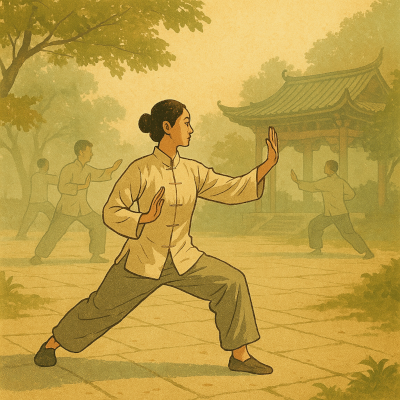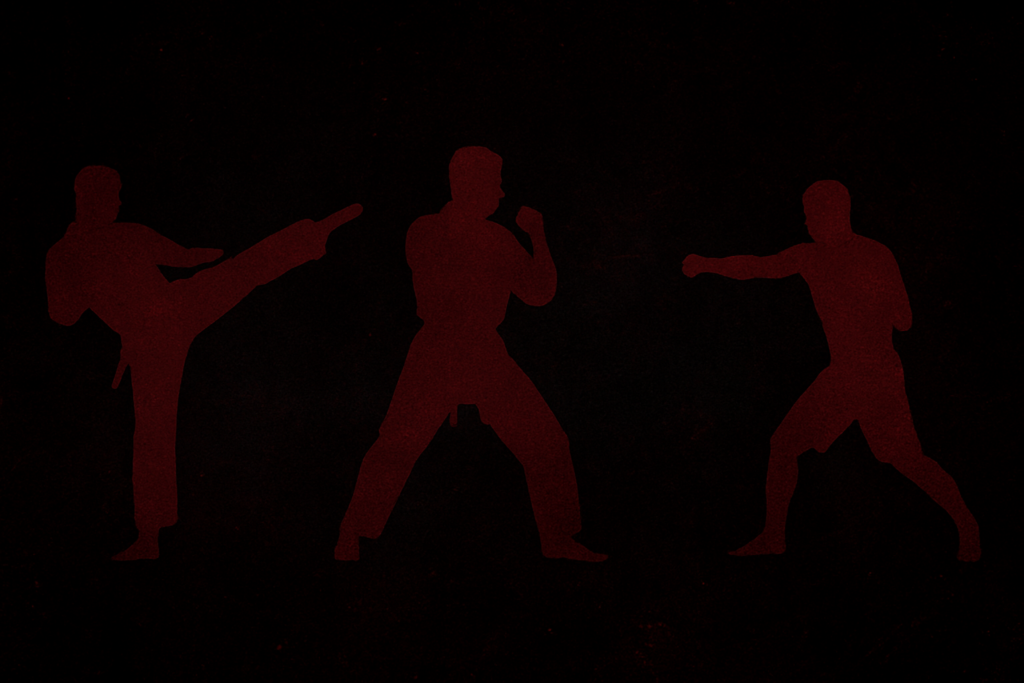The Gentle Art of Balance, Flow, and Inner Strength
🧠 A Brief History of Tai Chi

Tai Chi (Taijiquan, 太极拳), often translated as “Grand Ultimate Fist,” is a traditional Chinese martial art known for its slow, flowing movements and deep meditative focus.
It originated in 17th-century China, blending martial application with Daoist philosophy, breathing techniques, and internal energy cultivation (Qi Gong).
While it shares roots with Kung Fu, Tai Chi evolved into a distinct “internal martial art” (Neijia) — focusing less on external force and more on the harmonious flow of energy (Qi) within the body.
It was originally a combat art emphasizing timing, leverage, and redirection — but over time, it became just as renowned for promoting health, balance, and longevity.
🥋 Main Characteristics of Tai Chi
- Core Principle: Harmony of body, breath, and mind through continuous movement.
- Training Focus: Posture, breathing, balance, and smooth transitions.
- Philosophy: Yin and Yang — strength through softness, motion through stillness.
- Objective: Develop internal energy, mindfulness, and physical health.
Although Tai Chi appears gentle, its principles of alignment and energy redirection are deeply rooted in martial efficiency — the same energy that powers striking or grappling in other arts.
⚔️ The Philosophy of Tai Chi
Tai Chi is both a martial practice and a form of moving meditation.
Its guiding philosophy comes from Daoism, which teaches that harmony and adaptability create true power.
As Tai Chi masters often say:
“Be still as a mountain, move like a great river.”
This balance of stillness and motion makes Tai Chi a lifelong discipline — one that strengthens not only the body, but also the spirit.
🏯 Major Styles of Tai Chi
Over the centuries, several main Tai Chi lineages developed — each emphasizing different qualities of movement and energy control.
| Style | Founder / Family | Characteristics |
|---|---|---|
| Chen Style | Chen Wangting (1580–1660) | The oldest style; combines soft flow with bursts of power (fa jin). |
| Yang Style | Yang Luchan (1799–1872) | Most widely practiced; smooth, open, and slow movements ideal for beginners. |
| Wu Style | Wu Jianquan (1870–1942) | Compact movements and forward-leaning postures; focuses on energy sensitivity. |
| Sun Style | Sun Lutang (1861–1932) | Blends Tai Chi, Xing Yi, and Bagua; light footwork and graceful flow. |
| Hao Style | Wu Yuxiang (1812–1880) | Small, precise movements emphasizing internal focus and balance. |
Each style embodies the same core idea: move with the flow, not against it.
💪 Training in Tai Chi
A Tai Chi session usually combines gentle movement, breathing, and mental awareness.
While it looks calm, it builds deep physical and neurological benefits through mindful repetition.
Common training elements include:
- Forms (Taolu): Sequences of postures performed slowly and continuously.
- Push Hands (Tui Shou): Partner drills to develop sensitivity and balance.
- Breathing Exercises (Qi Gong): Cultivates energy flow and relaxation.
- Meditation and Visualization: Strengthens focus and calmness.
This combination of movement and mindfulness makes Tai Chi a complete mind-body exercise.
🧍♂️ Who Can Practice Tai Chi?
Tai Chi is among the most inclusive martial arts — adaptable for all ages and fitness levels.
| Group | Benefits |
|---|---|
| Children | Improves focus, patience, and coordination. |
| Adults | Reduces stress, enhances flexibility, and improves posture. |
| Seniors | Boosts balance, mobility, and cognitive health — proven to reduce fall risk. |
Its gentle, low-impact nature makes Tai Chi accessible to everyone, even those recovering from injury or illness.
🌿 Benefits of Practicing Tai Chi
Physical Benefits:
- Improves balance, posture, and joint mobility
- Enhances coordination and strength through gentle resistance
- Boosts cardiovascular and immune function
Mental Benefits:
- Reduces anxiety and promotes calmness
- Sharpens concentration and memory
- Encourages mindfulness and emotional stability
Spiritual & Lifestyle Benefits:
- Connects mind and body through breathing
- Promotes inner peace and resilience
- Encourages long-term health and graceful aging
🥇 Tai Chi as a Martial Art
Though practiced slowly, Tai Chi’s core techniques apply directly to real-world self-defense — emphasizing timing, redirection, and leverage rather than brute strength.
Advanced practitioners train to issue explosive energy (Fa Jin) and to “listen” to an opponent’s force (Ting Jin).
The result is a martial art of effortless efficiency — one that teaches harmony instead of confrontation.
🌸 Why You Should Try Tai Chi
Tai Chi offers a peaceful, lifelong way to cultivate strength, focus, and balance — without impact or aggression.
It’s a perfect complement to any martial art, fitness routine, or meditation practice.
☯️ Through stillness, you move; through softness, you grow stronger.

